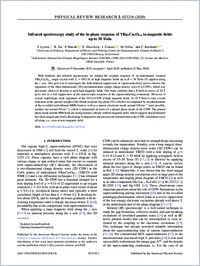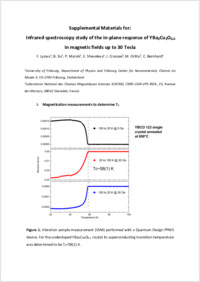Infrared spectroscopy study of the in-plane response of ${\mathrm{YBa}}_{2}{\mathrm{Cu}}_{3}{\mathrm{O}}_{6.6}$ in magnetic fields up to 30 Tesla
- Lyzwa, Fryderyk University of Fribourg, Department of Physics and Fribourg Center for Nanomaterials, Chemin du Musée 3, CH-1700 Fribourg, Switzerland
- Xu, Bing University of Fribourg, Department of Physics and Fribourg Center for Nanomaterials, Chemin du Musée 3, CH-1700 Fribourg, Switzerland
- Marsik, Premysl University of Fribourg, Department of Physics and Fribourg Center for Nanomaterials, Chemin du Musée 3, CH-1700 Fribourg, Switzerland
- Sheveleva, Evgeniia University of Fribourg, Department of Physics and Fribourg Center for Nanomaterials, Chemin du Musée 3, CH-1700 Fribourg, Switzerland
- Crassee, I. Laboratoire National des Champs Magnétiques Intenses (LNCMI), CNRS-UGA-UPS-INSA, 25, Avenue des Martyrs, 38042 Grenoble, France
- Orlita, M. Laboratoire National des Champs Magnétiques Intenses (LNCMI), CNRS-UGA-UPS-INSA, 25, Avenue des Martyrs, 38042 Grenoble, France
- Bernhard, Christian University of Fribourg, Department of Physics and Fribourg Center for Nanomaterials, Chemin du Musée 3, CH-1700 Fribourg, Switzerland
-
22.05.2020
Published in:
- Physical Review Research. - 2020, vol. 2, no. 2, p. 023218
English
With terahertz and infrared spectroscopy we studied the in-plane response of an underdoped, twinned YBa2Cu3O6.6 single crystal with Tc=58(1)K in high magnetic fields up to B=30 Tesla (T) applied along the c axis. Our goal was to investigate the field-induced suppression of superconductivity and to observe the signatures of the three-dimensional (3D) incommensurate copper charge density wave (Cu-CDW), which was previously shown to develop at such high magnetic fields. Our study confirms that a B field in excess of 20 T gives rise to a full suppression of the macroscopic response of the superconducting condensate. However, it reveals surprisingly weak signatures of the 3D Cu-CDW at high magnetic fields. At 30 T there is only a weak reduction of the spectral weight of the Drude-response (by about 3%), which is accompanied by an enhancement of the so-called mid-infrared (MIR) band as well as a narrow electronic mode around 240cm−1 (and, possibly, another one around 90cm−1), which is interpreted in terms of a pinned phase mode of the CDW. The pinned phase mode and the MIR band are strong features already without magnetic field, which suggests that prominent but short-ranged and slowly fluctuating (compared to the picosecond infrared timescale) CDW correlations exist all along, i.e., even at zero magnetic field.
- Faculty
- Faculté des sciences et de médecine
- Department
- Département de Physique
- Language
-
- English
- Classification
- Physics
- License
-
License undefined
- Identifiers
-
- RERO DOC 328656
- DOI 10.1103/PhysRevResearch.2.023218
- Persistent URL
- https://folia.unifr.ch/unifr/documents/308815
Other files
Statistics
Document views: 155
File downloads:
- pdf: 160
- Supplementary material: 179

